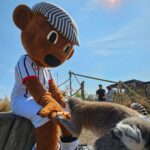Zazu’s Accident
We have been working around the clock to save the life of a rare Von der Decken hornbill which is part of a European wide breeding programme. Zazu unfortunately broke both his upper and then lower beak in separate accidents, making him unable to feed himself, relying on round-the-clock care from zookeepers to feed him and keep him hydrated.
We have had to hand feed Zazu his specialist diet of fruit and small insects including cockroaches. Zazu is nearing the end of his rehabilitation and his beak has somewhat repaired itself, allowing us the chance to finally become more hands off in his day-to-day management. A hornbill’s beak is made from keratin (the same as human fingernails and a rhinoceros’ horn).
Zazu who is critical to the European population of his species, is currently finishing his rehabilitation and it is hoped that he will still be able to mate upon the arrival of a suitable companion at the zoo later this year.
Zazu shares his free-flying enclosure with other bird species including Hamerkop, Turacos and Whistling Ducks. Once a suitable mate can be found for Zazu, he will be able to contribute to global breeding efforts to safeguard the species from extinction.
Von der Decken Hornbills are found in dry regions of Eastern Africa. Males like Zazu are easily identifiable by their large red bills, whilst females have black bills. Female Von der Decken hornbills bury themselves underground to hatch and rear their chicks with the male hornbill feeding the mother and chicks through a slit in the underground mud nest.
Mike said “Zazu is an incredibly intelligent bird, but without the intervention of our specialist zoo keeper team and veterinary professionals, the outlook would have been bleak for him. Thank full he responded well to hand feeding, with the zoo keepers initially giving him food via a pair of feeding tongs.”
“As he began to recover, Zazu developed a new strategy for feeding himself and he became
able to stab food with his beak and flick it in the air before catching and swallowing it. He’s now
in great condition and we hope to have a breeding companion for him at the zoo by the end of
the year so that he can contribute to European wide efforts to save his species from extinction.”





